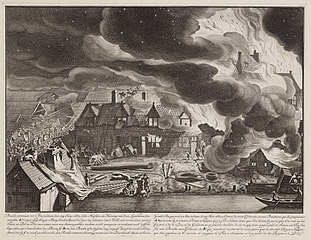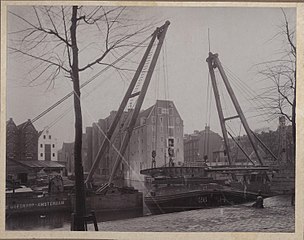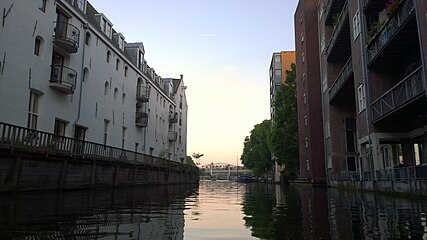Description
The Smallepadsgracht is on the west side of the Realeneiland and connects the Zoutkeetsgracht with the Realengracht and Prinseneilandsgracht. Unusually, there are no bridges over this canal, nor is there a quay that runs along the canal. Vierwindenstraat on Realeneiland terminates on the canal.
Smallepadsgracht originated in the defenses of Amsterdam added outside the Haarlemmerdijk and Hogendijk during the expansion of the city, with the active advice of Maurice, Prince of Orange. A path ran along the strongholds, ramparts and mills, the Smalle Pad (Narrow Path). The counterpart of the Lijnbaansgracht outside the dike was a ditch along that Narrow Path, sometimes called the Smallepadsgracht.
The Brandspuitenboek by Jan van der Heyden has is an etching of the path and canal: "Fire on June 24, 1680 in three ropemakers on the Schans on the Smallepadsgracht". Another engraving, attributed to Laurens Scherm, shows the ruins of the three burnt out lijnbanen. [3] On the Schutterswijkkaart from around 1770 the present Planciusstraat is named "Het Smalle Pad", with the Smalle Pads Graft converging towards the road at its northern end towards the lock on Zoutkeetsgracht.

Jan van der Heyden was a Dutch Baroque-era painter, glass painter, draughtsman and printmaker. Van der Heyden was one of the first Dutch painters to specialize in townscapes and became one of the leading architectural painters of the Dutch Golden Age. He painted a number of still lifes in the beginning and at the end of his career.

Amsterdam Impressionism was an art movement in late 19th-century Holland. It is associated especially with George Hendrik Breitner and is also known as the School of Allebé.

Katwijk aan Zee is a seaside resort located on the North Sea at the mouth of the Oude Rijn. It is situated in the municipality of Katwijk and the province of South Holland.

The Zwanenburgwal is a canal and street in the center of Amsterdam. During the Dutch Golden Age the canal was home to painter Rembrandt van Rijn, as well as philosopher Spinoza lived here. In 2006 it was voted one of the most beautiful streets in Amsterdam by readers of Het Parool, a local daily newspaper.

Joan Huydecoper van Maarsseveen II was the eldest son of burgomaster Joan Huydecoper van Maarsseveen I and the brother-in-law of the collector Jan J. Hinlopen and the sheriff Jacob Boreel. He was mayor of Amsterdam for 13 terms between 1673 and 1693. Unlike most mayors, he did not live at the Golden Bend, but on Lauriergracht in the Jordaan, where Govaert Flinck, Johannes Lingelbach, Jurriaen Ovens, who painted his portrait, the art-dealer Gerrit van Uylenburgh, and Melchior de Hondecoeter also lived.

Westelijke Eilanden are three islands in the Centrum district of Amsterdam: Bickerseiland, Prinseneiland and Realeneiland. They are located to the south of the IJ and the Zeeheldenbuurt, to the north of the railway line between Central Station and Amsterdam-Sloterdijk, to the west of the Westerdok and to the east of the Planciusbuurt on the Westerkanaal. The Westelijke Eilanden form the core of the Golden Reael area, which also includes the adjacent Westerdok island, the Haarlemmerbuurt and the Planciusbuurt.
August Aimé (Guus) Balkema, or A. A. Balkema, was a Dutch book trader and publisher active in Amsterdam and South Africa. He played a prominent role in the South African publishing world and was included in They shaped our century (1999), a list of the 100 most influential people in South Africa in the 20th century.
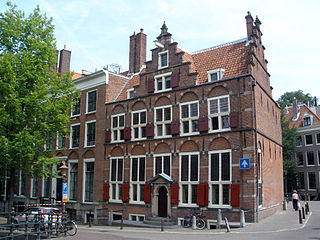
The Huis aan de Drie Grachten or Huis op de Drie Grachten is a 17th-century canal house in Amsterdam, at the southeastern end of the Wallen district. The name is a reference to the fact that the building faces three different Amsterdam canals. The south facade faces Grimburgwal, the west facade faces Oudezijds Voorburgwal and the east facade faces Oudezijds Achterburgwal. The address is Oudezijds Voorburgwal 249.

The Admiraliteitslijnbaan is a 17th-century building on Oostenburgergracht canal in Amsterdam. It has held rijksmonument status since 1970. A plaque on one side of the building commemorates Czar Peter the Great, who may have stayed here in 1697 during his apprenticeship at the Amsterdam shipyards.

The Bloemgracht is a canal in the Jordaan district of Amsterdam, the Netherlands. It connects the Prinsengracht with the Lijnbaansgracht and runs between and parallel to Nieuwe Leliestraat and Bloemstraat in the Amsterdam-Centrum district. The canal is named after the bulwark "de Bloem", later called "Rijkeroord". From 1614 a windmill was located here, but it was moved to Haarlemmerweg in 1878.

The Oudezijds Voorburgwal, often abbreviated to OZ Voorburgwal, is a street and canal in De Wallen in the center of Amsterdam. It runs from the Grimburgwal in the south to the Zeedijk in the north, where it changes into the Oudezijds Kolk, which drains into the IJ.

The Oudeschans, or Oude Schans, originally the Nieuwe Gracht, is a wide canal in the eastern part of the inner city of Amsterdam.
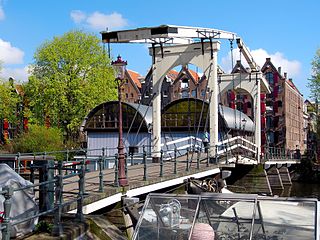
The Prinseneilandsgracht is a canal in the Centrum district of Amsterdam. It runs between Prinseneiland, an artificial island, to the east and the mainland to the west. Until after World War II (1939–45) the canal was bordered almost exclusively by warehouses and factories.

The Spuistraat in downtown Amsterdam connects the Hekelveld to the Spui. It runs roughly north to south, parallel to the Singel and the Nieuwezijds Voorburgwal. At the Royal Palace of Amsterdam, the Spuistraat crosses the Raadhuisstraat and Paleisstraat. Originally the Spuistraat was a canal, the Nieuwezijds Achterburgwal. The canal was filled up in 1867, and the street was then renamed.

The Doelisten were an orangist civic movement in Amsterdam, named after its primary meeting location the Kloveniersdoelen, which opposed the power of the Amsterdam mayors in the summer of 1748.
Events from the year 2023 in the Netherlands.
This page is based on this
Wikipedia article Text is available under the
CC BY-SA 4.0 license; additional terms may apply.
Images, videos and audio are available under their respective licenses.

